|
KEEP THIS NEWSLETTER ALIVE!
NEED A WEDDING, ANNIVERSARY OR BIRTHDAY GIFT? |
||
|
Shop Online at WWW.IRISHNATION.COM
|
||

Stunning Engraved Signet Rings |

Beautiful Irish Phrase Engraved Rings |

Jewelery made from Genuine Irish Coins |
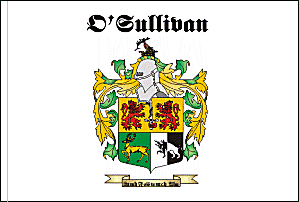
Family Crest Flags. White-Background or Ireland Flag |

Gorgeous Galway Crystal |

Marvellous Family Crest Shields and Plaques |
| More Gift Ideas From Ireland | ||
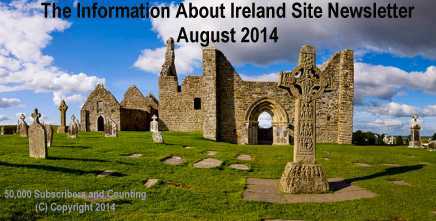
============
IN THIS ISSUE
============
=== News Snaps from Ireland
=== Belvedere House, County Westmeath
=== Clonmacnoise, County Offaly
=== The Fairie Ring - A Story by Neil Noble
=== History of the Vikings in Ireland
=== Gaelic Phrases of the Month
=== Monthly Free Competition Result
Popular Articles from Recent Newsletters:
Howth Gun-Running of 1914 Remembered
22 Quotes About Being Irish
Aillwee Cave, County Clare
==========
FOREWORD
==========
|
Hello again from Ireland where the mood is very much one of 'back to business' as the Summer months draw to an end while thoughts of economic and political matters come back to the fore. Ireland is in a transition period at the moment. The economy is recovering and unemployment is falling. For the first time since 2008 there is real hope and optimism in the air.
In this months newsletter we have articles about Belvedere House in County Westmeath and Clonmacnoise in County Offaly. Truly the carved stone crosses of Clonmacnoise have to be seen to be believed. A story from Neil Noble and an exploration of the Viking history in Ireland complete this months edition. Do email us an article or story if you have created one! Until next time, Michael |

PLEASE 'LIKE US' ON FACEBOOK!
P.S. Please DO FORWARD this Newsletter to a
friend or relative. If you have a website or Facebook
page or Blog (or whatever!) then you can help
us out by putting a link on it to our website:
www.ireland-information.com
Do tell your friends about us as this helps
to keep this newsletter free!
==========================
NEWS SNAPS FROM IRELAND
==========================
|
FORMER TAOISEACH ALBERT REYNOLDS DIES, AGED 81 Albert Reynolds resigned as Taoiseach on November 18th, 1994, having held the highest political office of the Irish State for a mere 3 years. His achievements of those few years are only now being acknowledged and in particular with regard to the fledgling 'peace process'. Albert Reynolds was instrumental in delivering the IRA cease-fire. He did so by collaborating, cajoling and stubbornly pursuing the road to peace with the previously intransigent IRA and British Government. It was also his stubbornness that would eventually cause the downfall of his Government and his resignation. 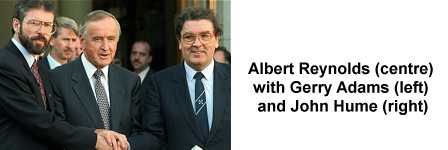
Albert Reynolds was elected from the Longford-Westmeath Constituency in 1977. He was rewarded by Charles Haughey for his support in the latter becoming Party leader with appointment as Communications Minister (Post and Telegraphs). He later became Minister for Finance but was sensationally sacked by Charles Haughey after Reynolds led an attempt to force him out of office in 1991. Haughey resigned a few months later and it was Albert Reynolds who became Taoiseach. His first Coalition arrangement with the Progressive Democrats (PD's) of the time was one that Reynolds suffered through and it became obvious that he had no liking for Coalition Governments. After only nine months as leader a General Election was called and although Fianna Fail lost nine Parliament seats they managed to form yet another Coalition Government, this time with the Labour Party. The early 1990's was not a great time in Ireland from an economic standing. The 'Celtic Tiger' had yet to rear his head and unemployment stood at over 300,000. Ireland had secured vital structural funding from the EU during Albert Reynolds time in office and this funding was vital in laying a foundation for the massive economic growth that was to follow later in the decade. But it is in Northern Ireland that his greatest moment would come. The 1993 'Downing Street Declaration' was a breakthrough in the recent history of Ireland and one that would lead to the 'Good Friday Agreement'. An IRA cease-fire and the momentum to a lasting peace in Ulster had been started by the man from Longford who is only now receiving the full credit that he clearly deserved. Relations with the Labour Party deteriorated and then collapsed, forcing Fianna Fail out of Government and marking the end of Albert Reynold's time as Taoiseach. In the years that followed the Irish economy took off to unprecedented heights while the peace agreement in Ulster was cemented. John Major, the British Prime Minister who forged the 'Downing Street Declaration' with Albert Reynolds wrote recently: 'Albert was not without faults. He could rarely pass a microphone without comment. He thought aloud and in company and was never Trappist in his views – even when he should have been. He could be cavalier in his concept of what was agreed. But he was brave, determined, open-hearted, and preferred agreement to dissent and friendship to enmity. Ideology was not in his nature. He was a pragmatist in search of a deal. In that old-fashioned phrase, he was a good man: good to do business with, and good to have as a friend.' GENERAL ELECTION COULD BE CALLED AT ANY MOMENT There is nothing like the thought of being turfed out on your ear to focus the minds of politicians. Already talk about 'the great giveaway' has begun in earnest with calls from the Labour Party for an increase in pay for Public and Civil Servants! And this is while the country is still massively indebted and with an unemployment rate of over 11.5%. The economy is showing signs of recovery though and every sitting T.D. (member of the Irish Parliament) wants to be able to offer some comfort to their constituents, be it a reduction in tax or an increase in local spending. The silly season is about to descend upon us. 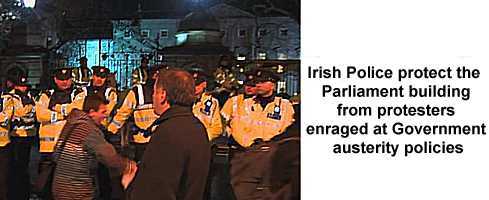
The big set-piece of course is the 'Budget' which will be unveiled in a matter of weeks. The annual Budget sets out the Government spending for the coming years and is always a subject of hot debate with those losing out generally being afforded the TV and radio airwaves to voice their gripes. Over the last few years the focus has been very much on 'austerity' with a battered and bruised Irish public reluctantly accepting all that their Irish masters (and European masters) have had to throw at them. This time things are a little bit different. With better than expected public finances and tax income there is a bit of wiggle room for the current Finance Minister Michael Noonan to offer a few crumbs to the masses. With economic experts preaching prudence and his own political colleagues preaching 'giveaway' he has his work cut out for him. And after the Budget is the election. The upcoming General Election is perhaps one of the hardest to predict in the history of Irish politics. This is because Ireland has never before had a political landscape like the current situation. Fine Gael and Labour were elected on foot of the collapse of the Irish economy, the implosion of the banks, the takeover by the German led EU/IMF/ECB troika and then years of austerity. Fine Gael continued to beat the drum of 'it is all Fianna Fail's fault and we are only cleaning up the mess' and for a while that worked. But when the public realized that the Political Parties they elected to do something different to what Fianna Fail had been doing were actually implementing the same Fianna Fail policies, they began to see all of the main protagonists in a somewhat different light. The Labour Party are sure to suffer most. Elected on a mandate of 'burn the bondholders' (meaning that the Government should not repay certain types of bank debt) the Party did little in office except rubber-stamp the hated 'Property Tax'. Its rivals on the left wing of Irish politics, Sinn Fein and the Socialist Party are certain to remind the electorate of that. Fine Gael are facing the prospect of doing all of the hard work, enduring the pain, but perhaps not reaping any reward now that the economic fortune of the country is facing bluer skies. It seemed inconceivable only a matter of a year ago that they could not just breeze back into office for a second term. Who could possibly replace them? For many people the answer to that question is now 'Anyone!'. And what of the inexorable rise of Sinn Fein. So often has this left-wing Party polled well in advance of an election but fared poorly at the actual ballot box. But no more. The Party looks set to decimate the Labour Party and perhaps hold the balance of power when the votes are cast. With neither Fine Gael nor Fianna Fail willing to enter into a Coalition with Sinn Fein the only logical choice is that these two former enemies do the logical thing - and form a coalition with each other. This is a previously ridiculous thought that looks ever more likely - unless the fickle electorate is kinder to Fine Gael and Labour than current polls would suggest, in which case Fine Gael could hack together a grand Coalition with the help of independent T.D.'s. All to play for as we approach the centenary of the 1916 Easter RIsing. DUBLIN TOURISM TO BOOST CONSTRUCTION SECTOR In a fine example of one part of an economy boosting another the continued growth in Irish Tourism looks set to invigorate the ailing construction sector. On its knees after the 2008 collapse the building industry is making a comeback. 
A big increase in private home renovations has coupled with a shortage of housing in certain parts of the city to make the future for plasterers, bricklayers and decorators a little more promising. An now the head of the Irish Tourism Industry Confederation (ITIC), Eamonn McKeon, has reported that as many as 5000 new beds in hotels and hostels are needed in the city to meet the demand from tourists flocking to the nations capital. He remarked: 'Tourists want to be in the city centre. The scarcity is in the central Dublin 1, 2 and 4 (postcode) areas. People who have travelled want to be able to walk.' The marketing of Irish Tourism is one of the success stories of the austerity years in Ireland. Events such as 'The Gathering' have focused the hearts and minds of people of Irish descent onto their native homeland with tens of thousands answering the call. The quality of hotels throughout the country is generally very good while the much improved road transport network is one of the better legacies of the now slain 'Celtic Tiger'. Niche opportunities such as the marketing to Cruise Ships to get them to dock in the city have been a great success. Even the weather has joined in with recent years actually providing some sunshine. The extent of the Tourist industry comeback has been demonstrated by hotel figures suggesting that occupancy in Dublin city hotels is back to where it was in 2008. The flip-side for the industry is that hotel rooms today cost more than a fifth less than they did back then. IRELAND TRAINS DOCTORS FOR EMIGRATION As many as one third of all doctors practicing in public hospitals in Ireland are from abroad, mainly from Pakistan, India and South Africa. The Irish Medical Council has issued a report showing that nearly one in ten young doctors leave their Medial Register, many to emigrate and practice abroad. 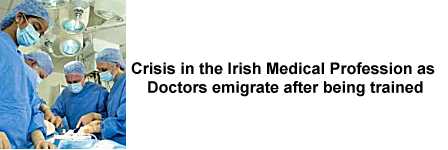
Tony O'Brien is the head of the Irish Health Services Executive: 'We want to ensure we can be competitive, to retain our own trainees, to attract back trainees who are going to different institutions abroad.' The shortage of doctors has been highlighted by the case in County Clare of the second failure there to fill a General Practitioner position. The local Community Council and a businessman even offered a building free of rent to any doctor who would apply. No takers so far. |
|
KEEP THIS NEWSLETTER ALIVE! Free Mount with ALL Family Crest Prints, Framed or Unframed 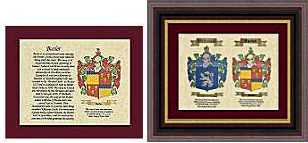
Order from Here |
Find Your Name in our Gallery of Irish Coats of Arms:
| A | B | C | D | E | F |
| G | H | I | J | K | L |
| M | N | O | P | Q | R |
| S | T | U | V | W | Y |
THE PERFECT WEDDING, ANNIVERSARY OR BIRTHDAY GIFT!
We have worldwide names available.
Get the Coat of Arms Print, Claddagh Ring,
Screensaver, Plaque, Tee-Shirt or Clock for
your name at:
https://www.irishnation.com/familycrestgifts.htm
|
======================================= BELVEDERE HOUSE, COUNTY WESTMEATH ======================================= Belvedere House and Gardens are located just outside the bustling town of Mullingar, just off the main Dublin to Galway motorway. The house is about an hours drive from Dublin and about half-way to Athlone from Dublin so if you are making the drive from the capital city to Athlone or on to Galway and the West of Ireland then Belvedere is on the way. Be warned though, this is not a place for a quick stop-off! Apart from the tour of the restored house, the grounds boast some excellent lake-side walks, a very fine walled garden with extensive flower borders that would even rival those found at Powerscourt in Wicklow. A kids playground and some farm animals are located beside the modern food court and shopping area. There is lots to see and do! 
The tour of the house is fascinating. There are some notorious stories of the owners of Belvedere, the Rochforts, and in particular Robert Rochfort who had his wife locked away for 31 years. He built a massive wall that still stands, just to obscure the view afforded by his brother who lived nearby - the infamous 'Jealous Wall'. These were very strange people! The house was built in 1740 and is set on 160 acres of parkland and lakes. Belvedere House was bought by the Irish State in 1982 and has undergone much renovation. The house is not especially big but is noted for its Diocletian Windows and dramatic nineteenth-century terracing as well as the superb Rococo plasterwork on the interior ceilings. The house and grounds are occasionally host to weekend music festivals and to intimate garden theatre performances. Beyond the main building children will love exploring the Greenhouse as well as the Fairy Garden that is attached to the walled garden and flower beds. The Playground and fine Cafe will interest them also but bring them for a walk around the forest grounds first! Down by the Lake and around to the Ice House and Gothic Arch. You could easily spend half a day or more exploring Belvedere. Bring a picnic and have a ramble. Well worth a visit. Find out more here: http://www.belvedere-house.ie ============================== CLONMACNOISE, COUNTY OFFALY ============================== The ancient Monastery at Clonmacnoise is located in County Offaly in the very heart of Ireland, just south of Athlone. The Monastery was founded in the year 546 by Saint Ciarán, who was one of the Twelve Apostles of Ireland and was located on the shores of the mighty river Shannon. It was thus perfectly situated on the main crossroads of medieval Ireland. Crafts-workers, pilgrims, scholars and traders all gravitated to the settlement that was eventually to grow into one of the most important destinations in the country. As well as being a place of scholarly and religious learning Clonmacnoise later became associated with the Kings of Connaught and the Kings of Meath. The story of how the young Ciarán met Diarmait Uí Cerbaill who helped him build the first Church at Clonmacnoise and who would later become the first Christian King of Ireland, is the stuff of legend. Ciarán died shortly after the Church was built, at just 33 years of age. His legacy remains. 
The heyday for Clonmacnoise was from the eight to the thirteenth centuries. As a seat of learning and religion it was also home to a great deal of wealth that was plundered regularly by the Vikings and later by the native Irish tribes and the Normans. Estimates of the population of Clonmacoise put the figure at 2000 people, a sizeable settlment in the eleventh century. The skill of the craftsmen working at Clonmacnoise was unsurpassed in Ireland with perhaps the pinnacle of their achievements being the Clonmacnoise Crozier and the famous High Crosses. From the twelfth century onwards the influence of Clonmacnoise began to decline. The main reason was the growth of nearby Athlone, also located on the river Shannon, but much better protected with its impressive Castle. As the population of Clonmacnoise dwindled the site began to fall into disrepair leaving its incredible legacy of stonework and medieval architecture to brave the elements for centuries. Clonmacnoise is located just a short boat-trip or bus-ride from Athlone, Tullamore or Birr, the main towns in the region. A modern interpretive centre displays the huge and magnificent stone crosses of Clonmacnoise, that were moved indoors for protection quite recently. A video presentation runs regularly to set the site in its historical context and afterwards the ruins and buildings are freely accessible. If you cannot take a good photo here then never touch a camera again! A small cafe and an external gift shop are also available. The ruins at Clonmacnoise exist among the fields and floodplain that border the river Shannon. It is easy to see how the site was abandoned and left to the overgrowth of plants and trees for centuries. For modern visitors this turned out to be a great advantage. The Book of Kells that is housed in Trinity College in Dublin regularly tops the list of most frequently visited tourist attractions in Ireland. Set in the heart of Dublin city it is very easy to access the site, view the books and the Library and then make your way to the next attraction without too much effort. By contrast Clonmacnoise does take a little effort to view. Offaly is off the beaten track from a tourist perspective. Nearby Birr and Athlone Castles and the boating on the Shannon are among the most popular reasons for visitors to arrive in Offaly. But for those who make the effort there is certain reward. The Book of Kells was created about the year 800 AD, approximately the same time as the famous High Crosses of Clonamcnoise. But these are artifacts that you can actually touch, actually feel the texture, actually place your hand where our ancient ancestors toiled and carved their utterly incredbile designs. Walking out into the Monastery ground and graveyard it is easy to imagine the High Kings of Ireland berthing at the nearby river, arriving to pay homage at one of the most sacred sites in all of Ireland. You are just not going to get the same feeling elbowing your way through the crowds at Trinity College to catch a glimpse of a decorated page protected under glass and dim lighting. If it is your intention to spin around the main tourist attractions in Ireland, perhaps you are on a tight schedule, then Clonmacnoise may not be on your radar. That is fine - it does take a wee bit of effort to get there. But if you do visit you may be surprised by the modest entrance fee to Clonmacnoise - almost free - the cost of a couple of shots of coffee. Depending on your expectations, your outlook and the kind of person that you are, it may well be the best few Euro you will spend during your visit to Ireland. And possibly the highlight of your trip. Find out more here: http://www.heritageireland.ie/en/clonmacnoise/ |
; KEEP THIS NEWSLETTER ALIVE!
Get Great Family Crest Gifts at:
|
=================================== THE FAIRIE RING - A Story by Neil Noble =================================== I awoke this morning feeling pretty good all in all. The sky was blue, the sun was shinning and my aches and pains chose not to bedevil me. As I looked out over my neighborhood from an upstairs window, I noticed, across the street, beside an old oak tree, a circle formed of mushrooms. I thought to myself, lucky for them. I went about my morning business and was just a short ways up the street, walking my dog, when the lady of the other house happened to drive past. As she stopped to say, 'Good morning', I replied in kind and offered to tell her a story. And with her permission to hold up her journey for only a few minutes, I began my tale. 'Lisa, did you happen to notice the circle of mushrooms in your front yard?' 'No,' she replied, 'but thanks for mentioning it. I'll get rid of them when I return.' I told her she should leave them be. They served a purpose and proceeded to explain why. Many, many years ago, back in the Celtic Kingdoms, there lived a Druid poet priest. He and his brothers were the masters, as well as defenders, of land and lake alike. All bickering and battles immediately stopped and all deferred to their wise council whenever one passed by. The task of the poet priest was a necessary one for it also fell upon him, to set into verse, the oral history of the people of the land. Music was an integral part of life back then, much more so than books. Everybody could whistle, hum or even sing but very, very few could read. So successful was he; so widespread was his reputation, even the other inhabitants of the land eventually sought him out, as well, with their stories and tales. These 'Others' would be those that lived in the Middle Earth and deep within the wooded areas, nowhere near the areas populated by humans. This intentional isolation was a good thing too; because woe is it unto the human whose path crossed one of the 'Others' for that person was seldom heard from again. These were the dark days of ignorance and superstition and Priests and Lords of the Land. As I was saying, all the fairies, hobbits and leprechauns knew of the human ways and history, which is why they choose to live apart. Even so, they sought out the poet priest so he could set into verse their equally important histories as well. And perhaps, through the priest, the humans could learn to live in harmony with nature also. They were so pleased with the Druid poeteer, that they made a promise to him. If he was ever in need of their help, in any way whatsoever, he need only look and find a Fairie Ring, that circle of mushrooms that is now in your yard. He should stand in its center, focus his energy, and then speak aloud the sacred name given to him that day. Whatever he wished for would be immediately granted. And all these centuries later, there has never been so much as a cross word between the humans and the 'Others'. Although its probably a good thing that some distance is still kept between them both. Perhaps, one day, that long lost sacred name will again be spoken and there will again be a peace that will last several thousand more years. |
KEEP THIS NEWSLETTER ALIVE!

Get Your Family Crest Flag at:
https://www.irishnation.com/familycrestflags.htm
|
================================== HISTORY OF THE VIKINGS IN IRELAND ================================== The Vikings in Ireland have a story that stretches back to the eight century and culminates with the battle of Clontarf in 1014, and defeat at the hands of Brian Boru. 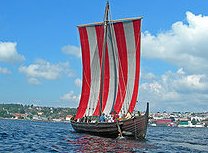
The earliest recorded raid from the Vikings out of Norway was in the year 795 at Rathlin Island off County Antrim in the North of the country. The Scottish isle of Iona was also attacked in the same year, the monasteries plundered and burned. By the year 802 the raids had stretched around the western coast as far as Skellig island off Kerry and the ancient monastery there. By the year 832 an intensification of the attacks occurred with fleets of Viking ships arriving at the Boyne, at Dublin and travelling the Shannon estuary. They took supplies, riches and slaves. They over-wintered for the first time in the year 840 settling at Louth and Dublin, using these bases for further attacks along the coast. The ancient word Viking is taken from the Norse word 'Vikingr' which means 'sea-rover' or 'pirate'. Their longboats gave them a distinct advantage that other sea-faring peoples just could not match. Their fierce attacks must have instilled terror into the local population and especially at the monasteries where much of the wealth they craved was located. It is no coincidence that the number of high-towers built for protection in Ireland greatly increased during this era. The sacred site at Clonmacnoise was repeatedly plundered. The Irish chieftains now began their defence in earnest since, as the Vikings had begun to make semi-permanent settlements they had become a much easier target. The Irish chieftain Máel Seachnaill is recorded as having routed the Vikings at Skreen in County Meath, putting more than 700 of the invaders to death. Alliances between the Vikings and the Irish chieftains became commonplace as the presence of the norseman became a political inevitability to be acknowledged and dealt with. By the year 849 invaders from Denmark had begun to attack not only the Irish but also the more established Vikings of Norwegian origin. By 853 'Olaf the White' had assumed control of Dublin. He married the daughter of Áed Finnliath, king of the northern Uí Néill. Decades of warfare with some victories and some defeats for the Vikings followed. In 902 the Irish defeated the Vikings at Dublin. A second round of attacks began in the year 914 with a large fleet of Vikings ravaging Munster. Over time the Irish fought back with some success. The Dublin Vikings were attacked by the King of Tara, the city sacked in the year 944. 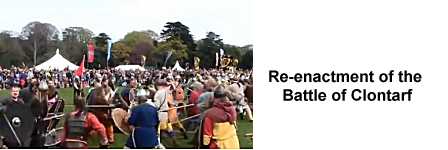
The stage was set for a great showdown between the two cultures with Brian Boru of Dál Cais in County Clare being the focal-point of the Irish attack. He had already defeated the Vikings in Munster. His great rival was Máel Sechnaill II, King of Tara. They reached an accord in the year 977 that Brian Boru would rule the southern part of the country with Máel Sechnaill II ruling the northern part. They even collaborated on a raid against the Dublin Vikings in the year 998. By the year 1000 Brian Boru had put down a revolt by the Dublin Vikings, defeating Sitric and eventually forcing Máel Sechnaill II to acknowledge him as the High King of all of Ireland. The Leinster Vikings again revolted in the year 1012 but were again defeated. They knew that their time was limited so they sought help from Sigurd, Earl of the Orkneys, who arrived in the early part of 1014 to face the Irish. The famous battle of Clontarf ensued with the Irish squaring up to Sigurd, Brodar and Ospak who were Vikings of the Isle of Man. Brian Boru, Brodar and Sigurd were all killed in the fierce battle that followed but the Vikings were eventually defeated, the battle entering the pantheon of myth and legend of Viking history. Estimates of the number of dead range from 6000 to over 12000, a huge number for warfare of that time. The Viking defeat at the battle of Clontarf effectively signalled the end of Viking rule in Dublin and thus throughout the country. Long before this battle though the inevitable integration of the two cultures had begun. The invaders even assimilated the native Christian religion, forming alliances, marrying and eventually settling among the native Irish. 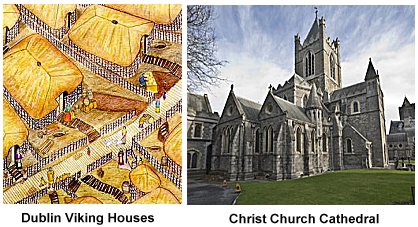
The legacy of the Vikings in Ireland is extensive. The towns of Dubin, Cork, Wexford, Limerick and Waterford that were initially founded by the Vikings all developed into the major cities of the modern era. A full-scale invasion of the island was never attempted as the Vikings had matters in England and France to deal with. Despite the attacks, the native Irish chieftains continued to prosper and make treaties, war with each other and the Vikings, sometimes allying with the 'norsemen' against rival chieftains. Coinage was first used in Ireland during the Viking era further providing evidence of the degree to which the Vikings changed from being raiders to merchants and settlers. The city of Dublin was especially transformed by their presence, with Christ Church Cathedral being built by Sitric. The layout of the city centre today is much as it was originally designed by the Vikings. Further proof of their integration survives the centuries through the use of surnames. Families of McAuliffe (son of Olaf), McManus (son of Manus), Doyle (the dark stranger or foreigner), McLoughlin (son of Lochlainn) and McIvor (son of Ivor) are just a few of the many 'Irish' names that have deep roots within the Viking heritage. The death of the leader Brian Boru marked a period of further fighting among the native Irish culminating with the Anglo-Norman invasion in the year 1169 and the beginning of a new period of warfare. It is a tragic fact of Irish history that the various chieftains and tribes remained so divided, unwilling to create a central leader or kingship capable of unifying opposition on the island to the invaders that were to follow. Centuries of domination by foreign forces would follow as a consequence. =============================== GAELIC PHRASES OF THE MONTH ===============================
View the archive of phrases here: https://www.ireland-information.com/irishphrases.htm ; KEEP THIS NEWSLETTER ALIVE! Get Great Family Crest Gifts at: ===================== COMPETITION RESULT ===================== The winner was: laurel.hobbs@rogers.com who will receive the following: A Single Family Crest Print (US$19.99 value) 
Send us an email to claim your print, and well done! Remember that all subscribers to this newsletter are automatically entered into the competition every time. I hope that you have enjoyed this issue. 
by Michael Green, Editor, The Information about Ireland Site. https://www.ireland-information.com Click here to contact us Google+ PLEASE 'LIKE US' ON FACEBOOK! KEEP THIS NEWSLETTER ALIVE! Visit https://www.irishnation.com (C) Copyright - The Information about Ireland Site, 2014 P.O. Box 9142, Blackrock, County Dublin, Ireland Tel: 353 1 2893860 |